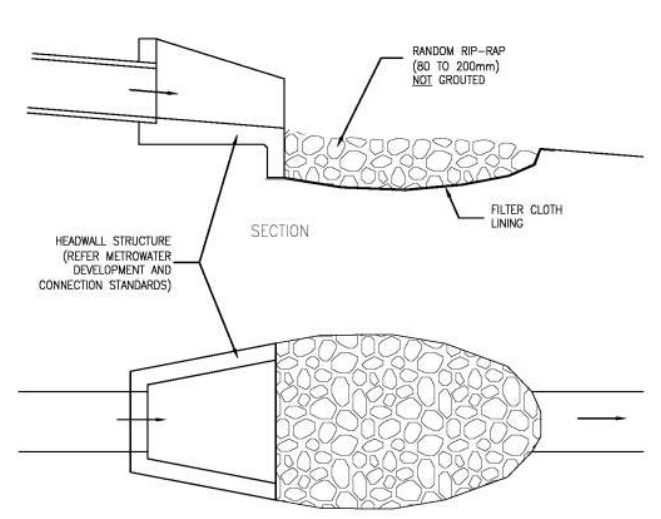Managing Stormwater in a commercial environment is a highly responsible job. The process starts with engineered solutions and calculations with plans the drainage installation contractor must follow.An incorrectly installed commercial Stormwater system can cause considerable damage and risk to health as well as property.Some areas this could include are:
- Commercial Subsoil drainage (please also view our residential subsoil drainage)
- Commercial grade wing walls and Rip-rap construction
- Heavy duty detention tanks and cesspits (concrete class)
- Soak holes and ground water management
- Public Stormwater connections and manhole installation. For more
information about our Public Drainage Services please CLICK HERE - Boreholes and test pits
- Stormwater pumped solutions and design
- Stormwater Pre-treatment devices and management
STORMWATER SOAKAGE ON COMMERCIAL PROPERTIES

On commercial sites subsoil drainage is important before and after construction. During construction a basic subsoil drain can keep the site clear of water allowing other works to take place. Subsoil drainage is considered in Foundation areas, retaining walls, along footpaths and driveways. In many instances builders install the subsoil drainage not realising there is a whole range of compliances involved. Catchment with subsoil drainage applications must be managed and discharged to approved points of outfall. Approved points of outfall include Natural streams, Public storm water connections, Soak holes, detention tanks and pumped solutions. In New Zealand all subsoil drainage must be treated before discharged into a public system.
Piped subsoil drains must be provided at all locations where ponding of water is likely, and at any location where groundwater may rise to the subgrade (e.g. natural springs or concentrated flow under steep roads). This includes at under-verticals or other areas where the footpath will otherwise be exposed to wet sheetflow for long periods from groundwater in the berm. Where subsoil drains pass within the planned root growth zone of trees, unperforated pipe with sealed joints must be used for the length of the zone, unless otherwise protected by their design. The principles of subsoil drainage design are detailed in Austroads Guide to Road Design. This can be downloaded HERE
For more information on subsoil drainage please call CLICK HERE or call us on 0800 DRAINLAYER.
CATCHPITS (CESSPITS)
Public catchpits are provided to drain the carriageway and for sediment or silt retention. Catchpits used in all public roads must comply with this Code of Practice.
Road drainage is managed jointly by AT and Auckland Council Stormwater Unit (SW) and approval is required from AT and SW for any work affecting this system and from Watercare in the Combined Sewer Areas. All catchpits draining to combined networks must have a water-trap discharge, to prevent odours from the combined sewer system escaping from the catchpit. This should generally be in the form of a half-siphon as shown in Plan Nos.RD032, RD035 or RD039.
All catchpits must include a silt trap sump at least 450 mm deep. Catchpits in town centres, or draining to streams, public beaches or amenity water as described in catchment Management Plans must be fitted with approved gross pollutant traps.
Grated channel drains or slot drains may be appropriate to drain some areas, especially flat areas with wide sheet flow or to intercept surface flow to protect vulnerable property below the paved area. Channel or slot drains
should only be used where areas cannot be laid to fall to surface channels or spread-entry treatment devices without significant problems such as trip hazards, excessive gradients or surface water inconvenience in areas of
heavy pedestrian activity. Every channel or slot drain must discharge to a catchpit designed to suit that channel system.
run-off flow from the minor drainage design storm, while limiting risk and
degree of interference with traffic, safety risk and risk of flooding due to
blockage.The following general guidelines should be used in the design of catchpits:
- Provide for the safety of the public from being swept into the stormwater system: openings must not pass an object greater than 100 mm least dimension. Openings must be sufficiently small to prevent entry of debris that would clog the stormwater system, or must include a screening element to protect the discharge pipe from debris entry
- Inlet capacity
a) Inlet capacity should be taken from manufacturers’ or suppliers’ data for approved types, or from verified testing of data for new types, or from approved design charts. Standard Catchpit 460 by 675 should be taken to have nominal inlet capacity of 28 l/s installed on gradient.
b) Corrections must be made for crossfall less than 3%.
c) Calculated catchpit inlet capacity must be reduced to allow for partial blockage of the
inlet as follows:
Catchpits located on gradients must be designed for their inlet capture capacity, and bypass flow must be added to the flow in the next sub-catchment. Catchpits at sag points must be designed for sump condition inlet capacity, and must be Double Standard Catchpits or Splay Catchpit, Street Catchpit 500 by 800, Megapit or other with sump inlet capacity allowing for blockage sufficient for design flow. Where ponding would lead to road safety or property flood risk, consideration should be given to a second catchpit and lead near the sag point.Drainage NZ have extensive experience with public and commercial stormwater systems which includes:
- Commercial stormwater channels (for more information about channels please CLICK HERE)
- Culverts
- Vehicle crossing and cut-off drains
- Oil grit arresters and stormwater management (Enviro-valves
- Charged and pumped stormwater systems.











